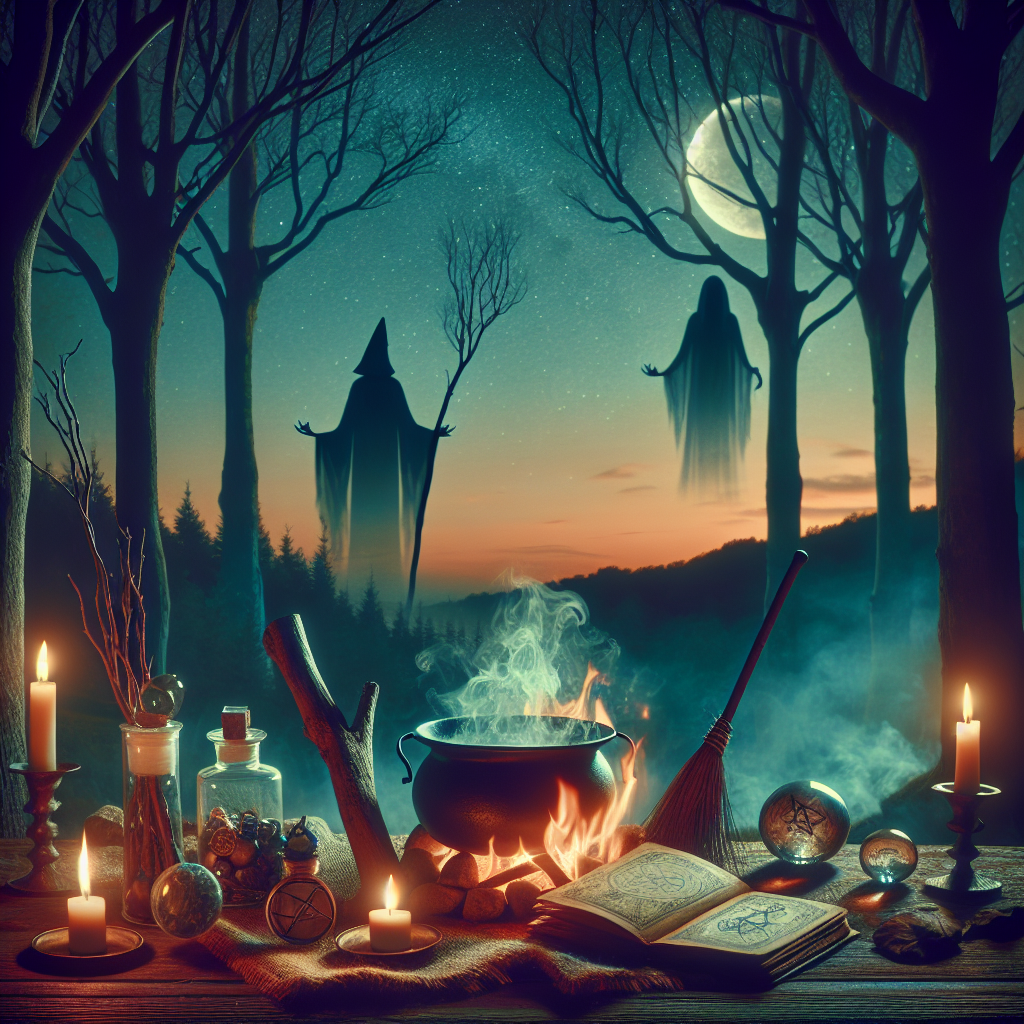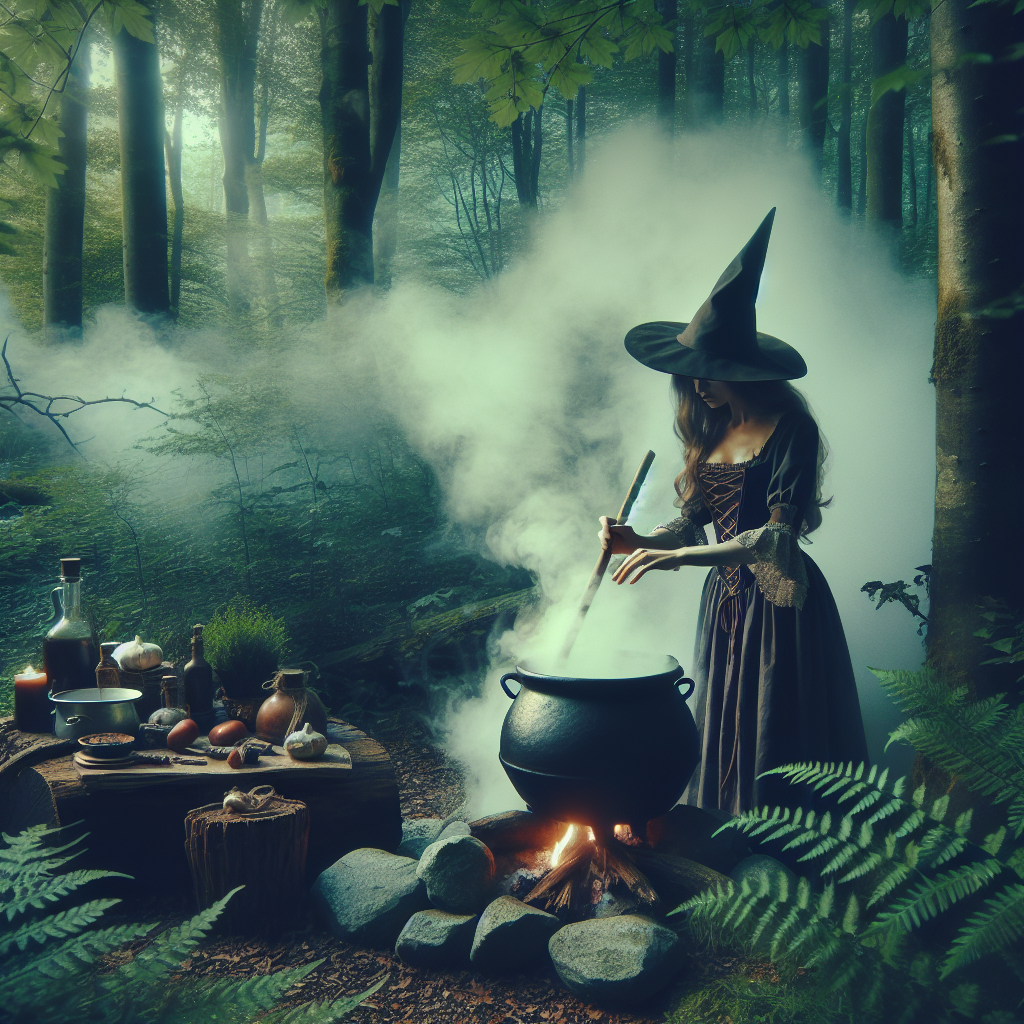As an Amazon Associate I earn from qualifying purchases.

Witchcraft, in its most basic form, is the practice of magical skills, spells, and abilities. It has been present in various societies since ancient times, with historical records dating back to the pre-Christian era. Often associated with a deep connection to nature and spiritual beliefs, witchcraft traditionally involves the use of supernatural or magical powers for various purposes ranging from healing to protection or harm.
The roots of witchcraft stretch far into the human past, with evidence of its practice found across continents and cultures. In many societies, individuals known as witches have been revered as wise healers and protectors, while in others, they have been feared and persecuted. The European witch hunts of the 15th to 18th centuries, for instance, reflect a dark period when thousands, predominantly women, were executed under the accusation of witchcraft. However, modern witchcraft, or Wicca, as it is frequently known, has seen a resurgence in recent times, partly driven by an increasing interest in pagan and earth-based religions.
One engaging element of witchcraft is its storied connection to the natural world and the seasons. Many practitioners celebrate eight sabbats or festivals that mark the turning of the year and cycles of the moon, known as esbats. Moreover, it is estimated that as of 2021, there are over one million people in the United States who identify as Wiccans or pagans, showcasing the growing appeal of alternative spiritual paths that honor nature and ancient traditions.
Witchcraft, in contemporary society, often advocates for the empowerment of the individual and the reclaiming of personal spirituality. Its practices emphasize self-discovery, respect for the Earth, and the use of magic as a means to effect positive change. The craft, as it is sometimes called by its practitioners, allows for a great diversity of beliefs and rituals, reflective of the unique perspectives and experiences of those who follow this path.
In conclusion, witchcraft's dynamics and complexities offer a rich tapestry of historical, cultural, and spiritual threads. Its adaptability and resurgence in modern spirituality hint at an enduring human quest for meaning, connection, and a more harmonious relationship with the natural world. As society continues to evolve, witchcraft is likely to morph and integrate new ideas, yet its essence will remain a point of fascination and relevance for many.
Unlocking the Mysteries of Witchcraft: A Comprehensive Guide
Witchcraft is a multifaceted phenomenon encompassing a blend of ancient practices, spiritual beliefs, and cultural rituals that aim to harness supernatural powers for varied purposes. Often grounded in the natural world and its energies, witchcraft can manifest in diverse forms, from traditional folklore and healing techniques to modern neo-pagan traditions. It has been perceived differently across eras and societies, with some viewing it as a positive connection to the earth and its cycles while others have historically demonized it. Beyond its most common associations with magic and the supernatural, witchcraft is also a lens through which we can examine social, historical, and psychological narratives. As you continue to the next section, we will delve into the rich tapestry that constitutes witchcraft, exploring its evolution, practices, and the enduring fascination it holds in the contemporary mind.
Witchcraft is a complex and multifaceted concept that encompasses a blend of ancient practices, spiritual beliefs, and cultural traditions. At its core, witchcraft is often defined as the use of supernatural or magical powers to influence the natural world, affect change in one’s personal life, or manipulate events or people. The term itself, witchcraft, can invoke a variety of images and ideas, ranging from the wise sage or healer of a village to the darker notions of malevolent sorcery often portrayed in popular culture.
The Historical Context of Witchcraft
To fully understand what witchcraft is, it's important to look at its historical roots. Witchcraft has been present in some form in nearly every human society. Historically, individuals practicing witchcraft, often referred to as witches, were thought to possess inherent powers or the ability to perform magic with the assistance of spirits or deities. In many cultures, these individuals served as healers, midwives, and spiritual leaders. However, with the rise of monotheistic religions and the spread of Christianity in Europe, witchcraft began to be seen as heretical and was heavily persecuted during events such as the infamous Witch Trials.
Witchcraft's Practices and Beliefs
The practice of witchcraft varies widely among different cultures and traditions. It can encompass a variety of rituals and practices, such as casting spells, divination, herbology, astral projection, and the working of traditional magic. Some common elements include the celebration of nature, the reverence of deities or spirits, and the use of ritual tools such as wands, cauldrons, and athames.
Many modern practitioners of witchcraft align themselves with neo-pagan religions such as Wicca, which itself incorporates elements of older pagan traditions and ceremonial magick into its practice. Wiccans follow a diverse range of paths but often hold in common the Wiccan Rede, which states, “An it harm none, do what ye will,” emphasizing the ethical stance of doing no harm to others or oneself.
Contemporary Witchcraft and Popular Culture
In contemporary society, witchcraft has experienced a resurgence in popularity, in part due to its portrayal in books, movies, and television. While these portrayals often sensationalize or oversimplify the practice, they have also helped to destigmatize witchcraft and have sparked interest in traditional and modern practices. Today's witches may incorporate a variety of ideologies into their practice, including feminism, environmentalism, and political activism, reflecting the adaptability and evolving nature of witchcraft as a spiritual practice.
Misconceptions and Prejudices
Despite its growing acceptance, many misconceptions about witchcraft persist. Common stereotypes paint witches as either benevolent crones or evil sorceresses, obscuring the rich diversity of witchcraft practices. Additionally, throughout history and in some places today, accusations of witchcraft can result in social ostracism, persecution, or violence towards those accused, demonstrating the powerful and sometimes dangerous misunderstandings surrounding this practice.
Global Variations
Globally, the practice of witchcraft takes on many different forms and names, often intertwined with the local culture and belief systems. For example, in African traditional religions, witchcraft can be an integral part of spirituality and community life, while in Latin America, practices like brujería combine indigenous and European influences. Such diversity is part of what makes defining witchcraft complex and context-dependent.
Statistical Insights
Recent statistics on the practice of witchcraft are challenging to pinpoint due to its private nature and the wide spectrum of practices encompassed by the term. However, data from organizations like the Pew Research Center indicate a growing trend towards more Americans identifying with pagan or Wiccan beliefs. As of their last survey, about 0.4% of Americans (approximately 1.5 million people) identify as Wiccan or pagan, showcasing the increasing visibility and practice of witchcraft-like religions in modern society.
1. What is the definition of witchcraft?
Witchcraft can be broadly defined as a practice involving magical skills and abilities that are exercised by solitary practitioners or groups. It is a complex, multifaceted cultural phenomenon that has taken different shapes in various cultures throughout history, often involving the use of rituals, spells, and the invocation of spirits.
2. Is witchcraft a religion?
Witchcraft itself is not a singular religion but is often associated with several religious practices. For some, it is a spiritual practice intertwined with Pagan religions such as Wicca or indigenous spiritual systems. For others, it is a secular practice independent of religious belief.
3. How does someone become a witch?
Becoming a witch varies from culture to culture and individual belief systems. In some traditions, it may involve a formal initiation, self-dedication rituals, inheritance of practices through family lines, or self-study and practice over time.
4. Are there different types of witchcraft?
Yes, there are many types of witchcraft that reflect the diverse beliefs and practices around the world. Some of the well-known types include Wicca, traditional or folk witchcraft, ceremonial magic, and eclectic witchcraft, each with its own set of practices and beliefs.
5. Can witchcraft be practiced by anyone?
Generally, witchcraft can be practiced by anyone interested in pursuing it. However, specific traditions may have certain prerequisites or guidelines for practitioners. It's important to research and understand these before engaging in any particular practice.
6. Is witchcraft dangerous?
Witchcraft is not inherently dangerous. Like any other spiritual or religious practice, it is the intent and actions of the practitioner that determine the nature of the practices. Responsible practitioners use their skills ethically and safely.
7. What is the historical significance of witch hunts?
Witch hunts were a tragic period in history, spanning several centuries, where individuals, usually women, were persecuted, tortured, and often executed based on accusations of witchcraft. These hunts were influenced by religious, economic, and social factors and have had a long-lasting impact on the perception of witchcraft.
8. How is witchcraft viewed in various cultures?
Witchcraft is viewed differently across cultures. In some traditions, it is respected and integrated as part of the cultural heritage. In others, it may be misunderstood or stigmatized due to historical prejudices or religious beliefs.
9. Can witchcraft coincide with other religious beliefs?
Yes, some people integrate witchcraft practices with their established religious beliefs, creating a personalized spiritual path. It's important to respect the norms of any religious tradition when doing so.
10. Where can I learn more about witchcraft?
There are many resources available for learning about witchcraft, including books, online forums, workshops, and community groups. It's important to approach learning with an open mind and critical thinking, especially when discerning between historical practices and modern interpretations.
Conclusion
In essence, witchcraft is a multifaceted phenomenon that encompasses a variety of practices, beliefs, and cultural expressions that vary across different societies and historical periods. From its roots in prehistoric times to contemporary neopagan movements, witchcraft has been both revered and reviled, manifesting as a spiritual practice, a form of healing, a source of empowerment, and, at times, a subject of persecution. The exploration of witchcraft reveals its significant role in shaping cultural lore and the collective psyche, influencing art, literature, and popular culture. Throughout history, witchcraft has often challenged established power structures and societal norms, thereby serving as a conduit for social and political commentary.
The article addressed key insights about witchcraft, including its portrayal in media and folklore, the variety of practices that constitute magical work, and the importance of intention and belief in the efficacy of such rituals. Understanding witchcraft requires a nuanced appreciation of its history and its ongoing evolution. As modern witchcraft continues to grow in popularity, it underscores a living tradition that adapts to contemporary contexts, allowing practitioners to explore spirituality and personal agency. By demystifying the misconceptions and acknowledging the genuine cultural significance of witchcraft, we gain a deeper comprehension of its place in human history and its relevance in the ever-changing tapestry of human belief systems and practices.
Amazon and the Amazon logo are trademarks of Amazon.com, Inc, or its affiliates.


